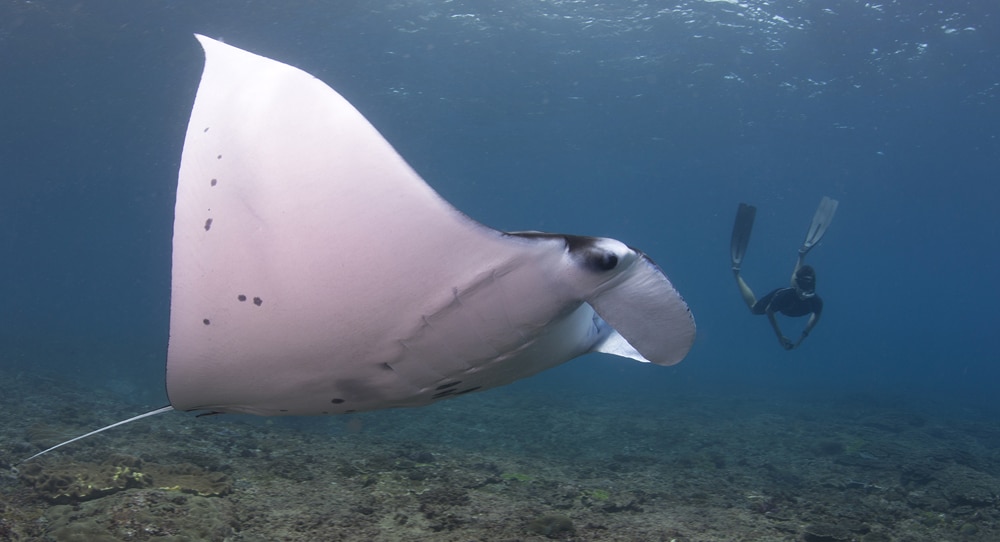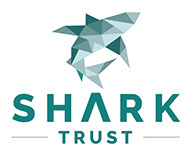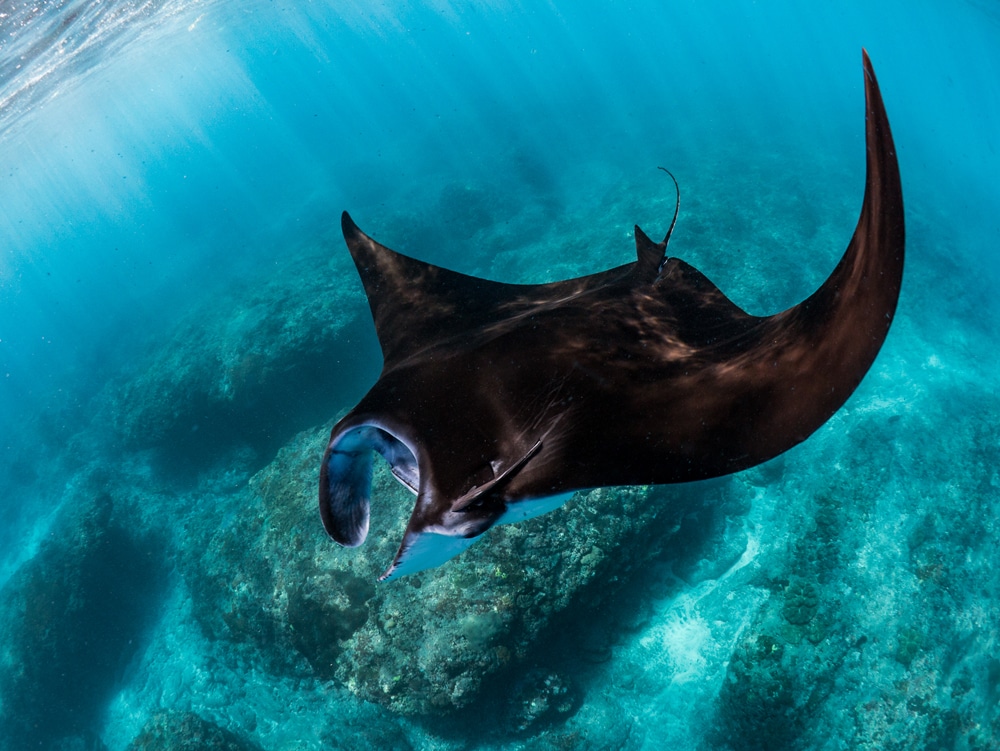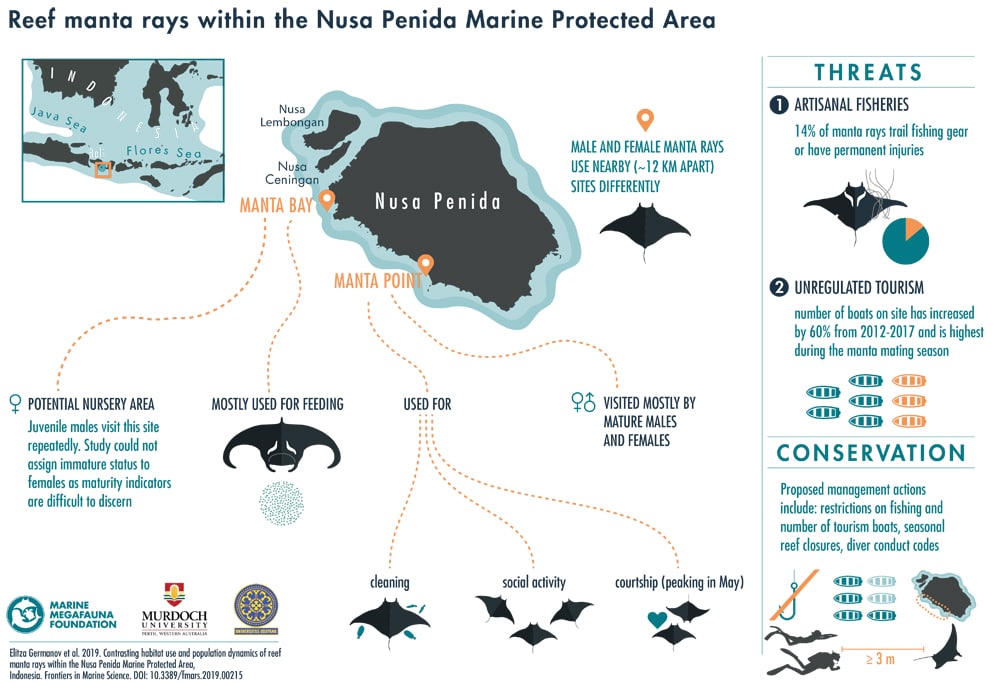Marine Life & Conservation
Tourists key to future of rare manta nursery

 Scientists from the Marine Megafauna Foundation and Murdoch University are reporting a large number of juvenile manta rays in the waters of Nusa Penida, a small island 18km southeast of Bali, suggesting the area may be a nursery for this threatened species.
Scientists from the Marine Megafauna Foundation and Murdoch University are reporting a large number of juvenile manta rays in the waters of Nusa Penida, a small island 18km southeast of Bali, suggesting the area may be a nursery for this threatened species.
Reef mantas (Mobula alfredi), which grow up to 5m, tend to reside and feed in shallow, coastal habitats. They also visit ‘cleaning stations’ on coral reefs to have parasites or dead skin picked off by small fish. In Nusa Penida, they are present year-round making the Marine Protected Area (MPA) a snorkeling and diving hotspot.
One of the popular dive sites (Manta Bay) described in this new study is predominantly frequented by juvenile males looking for food. Some are as small as 1.5m in disc width on first sighting, providing strong evidence that the site forms part of a nursery habitat and foraging ground for the local reef manta population. Most individuals have been seen repeatedly across multiple years.
“Where manta rays are born and grow up still baffles us. Our research in Indonesia suggests there might be a reef manta nursery in the Nusa Penida area and possibly also in the famous Raja Ampat archipelago”, said lead author Elitza Germanov. “It’s really important for us to know where these nurseries are. They provide a safe space for young, vulnerable manta rays to grow and develop away from the reach of predators.”
Interestingly, mature males and females seem to prefer Manta Point, a second dive site a mere 12 km away. Here, the manta rays are mostly observed visiting cleaning stations and engaging in social activity as well as courtship display during the mating season (peaking in May).
Nusa Penida attracts more than 200,000 tourists each year. Of the 11 main dive spots in these waters, Manta Bay and Manta Point are frequented most by tourism operators, putting the local manta ray population under increasing pressure. While manta rays are protected in Indonesia2, there are currently few regulations in place to manage the growing tourism industry. The number of boats allowed to enter manta ray habitats is not limited and codes of conduct for manta ray interactions are voluntary. The average annual number of boats present at the two manta ray sites has increased by 60% since 2012 and tourism is highest during the mating season.
Germanov commented: “Large diving groups and boat engine noise can cause chronic stress to these vulnerable animals. Tourists may disrupt the foraging, cleaning and mating behavior of manta rays if they get too close, which can have serious implications for their growth and fitness.”
Limiting the number of tourism vessels allowed at one time and making codes of conduct for diving and snorkeling with manta rays mandatory are proposed as a way to minimize the impact from tourism. Seasonal closure of Manta Point could also be considered to protect the manta rays from disturbance during the mating period.
Artisanal fishing poses a further threat to the local population. During the study, 14% of manta rays were either trailing hooks and lines or had injuries and even amputations from fishing gear cutting through their skin and cartilage skeleton. While all fishing activities are officially prohibited in both Manta Bay and Manta Point, the whole west coast of Nusa Penida could be closed off as a precautionary measure.
Dr Andrea Marshall, principal scientist and co-founder of the Marine Megafauna Foundation said: “This is clearly an important habitat for reef mantas. In fact, the resighting rates in the Nusa Penida MPA are higher than anywhere else in the world.
“The two aggregation sites are very close to each other but used for different purposes. We still don’t know much about when and how the mantas move between the feeding, cleaning and mating grounds. Putting the pieces of this puzzle together will help us figure out how to protect these slow-growing animals.”
For more information about the work of the Marine Megafauna Foundation visit their website by clicking here.
Marine Life & Conservation
Shark Trust launches Oceanic 31 Shark Art Auction

 After a two-year tour of UK art galleries, community spaces and aquariums, the Shark Trust’s acclaimed Oceanic31 exhibition takes its final bow at the Royal Geographical Society later this month. And the unique collection of artwork, depicting 31 species of oceanic sharks and rays, donated by 31 artists, is now open for bids from art lovers and shark enthusiasts. The online auction, launched today, will close on the 7th December at 8pm (BST). The money raised will support the Shark Trust Oceanics Programme.
After a two-year tour of UK art galleries, community spaces and aquariums, the Shark Trust’s acclaimed Oceanic31 exhibition takes its final bow at the Royal Geographical Society later this month. And the unique collection of artwork, depicting 31 species of oceanic sharks and rays, donated by 31 artists, is now open for bids from art lovers and shark enthusiasts. The online auction, launched today, will close on the 7th December at 8pm (BST). The money raised will support the Shark Trust Oceanics Programme.
People can now bid on 27 of the artworks by visiting this website:
https://superstars-auctions.com/sharktrustauction
It is a chance to own a beautiful piece of original art and to support the Shark Trust. The timing of the auction also means that these would make a very special Christmas gift for any shark-lover.
- Bigeye Thresher Shark by Janina Rossiter
- Carcharodon carcharias by Jimmy Higgs
- Croc VR 2030 by Tom Mead
- Oceanic Whitetip by ATM
- Silky Street by ScapaJoe
The diversity of pieces mirrors that of the sharks and rays they represent. You can bid on paintings, digital creations, sculptures, mixed media and more. You can pick your favourite artist or species of shark. Or you can select the perfect artwork to make a statement in your home or office. Whichever you choose, you will be supporting the work to protect these amazing animals.
One of the pieces of art has been selected to be auctioned live by Steve Backshall at the For the Love of Sharks event at the Royal Geographical Society in London on the 29th November. In addition to this, two further pieces will be raffled at this event, giving people a chance to win an incredible piece of shark art. For the Love of Sharks is the Shark Trust’s flagship evening. A night to celebrate sharks. Steve Backshall is the headline speaker at this event that will see other prominent shark advocates join him on stage.
Tickets for the event can be snapped up here:
https://thesharktrust.org.uk/Event/flos24
Those that would like to see the Oceanic 31 exhibition have one final chance. It is being displayed at the Pavilion at the Royal Geographic Society from 26th November until the 7th December. Entry is free.
Find out more here:
https://www.rgs.org/events/upcoming-events/oceanic-31
Paul Cox, Shark Trust CEO, Said “This exhibition has given us the opportunity to reach out to a new audience. And inspire more people with the wonderful sharks and rays on which our Big Shark Pledge campaign is based. We are immensely grateful to the 31 artists who have worked so hard to create these works.”
Bid for your favourite Oceanic 31 artwork here:
https://superstars-auctions.com/sharktrustauction
Banner Image: Smooth Hammerhead by Alicia Hayden
Marine Life & Conservation
Meet Steve Backshall in the Bite-Back Prize Draw

Until 28 November, prizes worth a massive £10,000 – including experiences, products and tuition – feature in a line-up of items that can be won for £5 in an online prize draw to celebrate Bite-Back Shark & Marine Conservation’s 20th anniversary and help generate crucial funds for the future.
Top of the list of prizes is the chance to spend time with adventurer and wildlife expert Steve Backshall, a workout session with Nat Geo star Aldo Kane, a kayaking trip alongside white-water expert and diver Sal Montgomery and a Zoom call with ‘shark whisperer’ Cristina Zenato.
On top of that, some of the most admired companies in the diving and scuba industry have been quick to support the charity with fabulous prizes that make the £5 ticket price worth more than just a flutter.
Master Liveaboards, BSAC, Midlands Diving Chamber, Go Freediving and Blue Shark Snorkel have all generously donated experience prizes, while celebrated photographer Alex Mustard has donated a print and artists Scott Gleed and Olivier Leger have donated a sculpture and illustration to help boost the fundraising pot.
Fourth Element has donated Ocean Positive gear and LA watch company Nodus has gifted the charity a stunning dive watch. For land lovers, the charity has included a five star London hotel stay at Bankside Hotel plus a family visit to Longleat Safari Park in the roster of prizes.
Campaign director for Bite-Back, Graham Buckingham, said: “We’ve been overwhelmed with support from companies and individuals that we truly admire and who have supported us on our 20 year journey and we’re truly grateful to them all. While we feel incredibly proud of our achievements over the past two decades – and we are super excited about the next chapter – this prize draw isn’t a vanity project. It represents a real lifeline to our work and important advancements in the global protection of sharks. So we hope divers, dive clubs and even bargain hunters grab some tickets to make this a massive success.”
The charity hopes that the prize draw will generate crucial funds to launch a brand new, ground-breaking, campaign to enrol the public and increase support for the protection of sharks around the world.
To enter the competition visit www.bite-back.com/prizedraw. The prize winners will be announced on 1 December 2024.
-

 News1 month ago
News1 month agoIconic SS United States to become the World’s Largest Artificial Reef
-

 Blogs3 months ago
Blogs3 months agoNovoScuba’s Game-Changing Approach for Dive Store Owners: WE PAY YOU!
-

 News2 months ago
News2 months agoBook Review – 52 Assignments: Underwater Photography
-

 Gear News2 months ago
Gear News2 months agoDYNAMICNORD – New German diving brand enters the British market
-

 News2 months ago
News2 months agoExploring Cenote El Pit: A Diver’s Dream
-

 Gear News2 months ago
Gear News2 months agoTry BARE drysuits (and maybe even win one!) this Friday with Sea & Sea at North West Dive Fest
-

 News3 months ago
News3 months agoComing Soon – 52 Assignments
-

 News3 months ago
News3 months agoSave £200 per person per week at Pole Pole Lodge with Dive Worldwide










